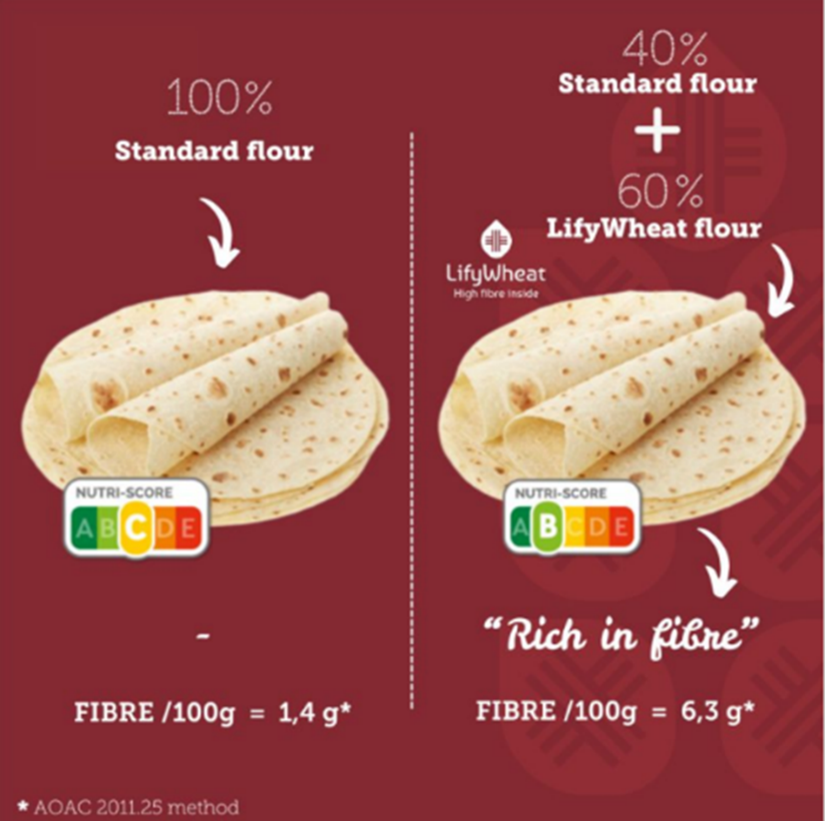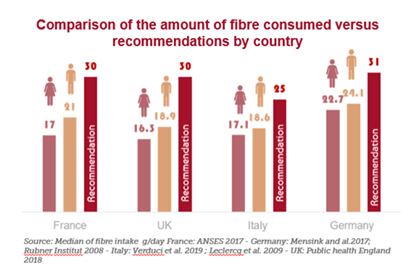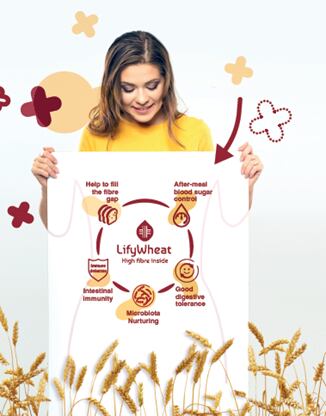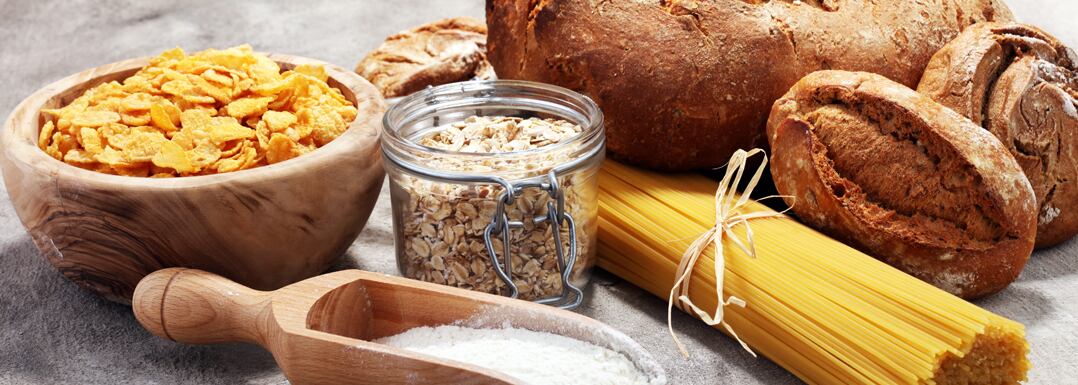Bakery products are an essential part of European culinary heritage and are enjoyed in most households.
In 2023 in France, bread, pastries and cakes represented 3,218 million units sold, generating €2,696 million in revenue.1 Other European countries are also following this trend. In Spain, bread sales are forecast to increase at a compound annual growth rate (CAGR) of 1.8% between 2021 and 2026, reaching $3.9 billion by 2026.
Italy was the EU’s biggest market for bakery and pastry products in 2021, and forecasts indicate more pronounced growth between 2021 and 2026, with a CAGR of 4.4%, reaching $26.3 billion in 2026.2
Their central position in people’s daily lives represents a lever for action for public health issues faced in society today. Obesity, diabetes, and other diseases are major concerns for public health, requiring us to seek new solutions to mitigate them. Prevention via nutrition is considered a key strategy. Scientific research into fibre has made significant advances, showing that it is an essential nutrient, yet fibre consumption remains low in the European diet.
With the aim of reducing the gap between health recommendations around fibre and Europeans’ actual consumption, Limagrain Ingredients has developed LifyWheat: a unique, pioneering flour stemming from 20 years of research.
“With LifyWheat, Limagrain Ingredients set itself the objective of helping European populations increase their daily fibre consumption. It is high in resistant starch, a form of dietary fibre, which gives it significant health benefits,” says Anne Lionnet, Head of New Business at Limagrain Ingredients and CEO at Arista Cereal Technologies.
Improving nutritional quality
Using LifyWheat flour raises the fibre content in products designed for use in a range of applications such as sliced bread, soft tortilla, biscuits and breakfast cereal. With the new Nutri-Score algorithm, a product’s score can be maintained or increased by replacing standard flour with LifyWheat flour. Nutri-Score is a nutritional label aiming to provide the consumer with quick information regarding nutritional quality adopted by several EU countires, to guide them towards purchases that support a more balanced diet.
In June 2022, its scientific committee suggested a suite of changes to the algorithm used to calculate the Nutri-Score for solid foods in order to make it more effective. One of the major changes involved placing more value on products’ fibre content, making it possible to increase their score and potentially the associated letter if a certain threshold is reached.3
With about 25% fibre, versus only 2.5% typically, LifyWheat represents an excellent nutritional alternative for the formulation of bakery products. For example, a soft tortilla made exclusively with standard white flour receives a Nutri-Score of C, with only 1.4 g of fibre per 100 g of product. By replacing 60% of standard white flour with LifyWheat flour, the fibre content rises to 6.3 g per 100 g of product, thereby achieving a Nutri-Score of B.

Increasing the quantity of fibre beyond a certain threshold in finished products means that products can display nutrition claims. A minimum of 6 g of fibre per 100 g of product is required for the claim ‘rich in fibre’ and 3 g of fibre per 100 g for ‘source of fibre’. These claims play a role in consumers’ purchasing decisions as one in two consumers pays attention to nutrition claims in the snack aisle.4
Flour high in fibre without compromise
LifyWheat flour combines the sensory advantages of white flour with the nutritional benefits of whole grain flour without the rustic taste and brown color. White flour, or refined flour, is produced from whole grains of wheat that undergo a refinement process. During this process, the bran and germ of the grain are removed, leaving only the endosperm to be made into flour. However, bran and germ contain an important quantity of vitamins, minerals, and fibre.
Whole wheat flour is produced from the entire grain (bran, germ and endosperm), which allows it to conserve these essential nutrients. That is why whole grain flour is considered to be healthier. Despite the recognised benefits of whole grains, consumer acceptance of these products remains low compared to those made from white flour.
Whole grain flour has certain sensory characteristics such as a brown color, a denser texture, a more rustic taste, which may be less attractive for certain consumers. Among the reasons cited for the reticence to consume products made from whole grains, 71% expressed a general preference for non-whole grain products while 33% cited a taste problem with products made from whole grains.5
Furthermore, certain consumers experience undesirable effects when digesting these fibres. For example, bran, which is found in wholemeal flour, can cause gas and bloating.
LifyWheat offers an alternative without compromise: it conserves the same flavor, texture, and manufacturing process as standard white flour, while offering a significantly higher fibre content and good digestive tolerance, thanks to its resistant starch content representing 80% of total fibre.
Responding to a public health challenge
Despite the benefits of fibre for health, there is still a significant gap between fibre consumption in European populations and recommendations from public health authorities in these countries. This gap is particularly wide in the UK, 17.6 g of fibre is consumed per day in comparison to the recommended amount of 30 g, a gap of 12.4 g. As for France, there is a gap of 11 g between recommendations and consumption. Italy and Germany have respective gaps of 7.15 g and 7.6 g.6 A diet low in fibre is associated with higher risks of developing multiple illnesses, such as diabetes, hypercholesterolaemia and obesity.

Figure 1: Comparison of fibre consumed versus recommendations by country.
Fibre positively supports microbiota
Consuming dietary fibre promotes gut health and a richer, more diversified microbiota, in symbiosis with its host. LifyWheat is an innovative solution with fibre content ten times higher than that of ordinary white flour, contributing significantly to promoting digestive health. Nearly 80% of this fibre is resistant starch. Its properties allow it to resist digestion and thereby nourish the intestinal microbiota promote the growth of beneficial bacteria. This action stimulates the production of short-chain fatty acids (SCFAs) by the microbiota, which play a crucial role in maintaining the integrity of the intestinal barrier and possess anti-inflammatory properties.

Inflammatory bowel diseases and other pathologies in relation with the digestive system are a group of gastrointestinal disorders characterized by chronic inflammation and dysbiosis in the intestinal microbiota. Overall, the beneficial properties of dietary fibre for inflammation make it a relevant candidate for preventing this kind of illness.
In general, a diet high in fibre is beneficial to reduce certain health risks, and has an association with risk of overall colorectal cancer.9 This is because it reduces intestinal transit time, with the bloating caused by certain types of fibre, and because of the positive role of SCFAs produced by the microbiota.9 With this in mind, using LifyWheat in bakery and pastry products represents not only a nutritional advance, but also a significant contribution to promoting optimal gut health and overall wellbeing.
The impact on the prevalence of diabetes and obesity
Other illnesses such as diabetes and obesity may be impacted positively by consuming fibre. In Europe, problems related to excess weight and obesity have reached high levels, with 59% of adults overweight or obese, and 1 in 11 adults diagnosed with diabetes.7,8 In the 18 countries of the EU the average rate of obesity has increased from 11% in 2000 to 15% in 2008, then to 17% in 2018.10
Diabetes is a chronic disease characterized by the presence of an excess of sugar in the blood called hyperglycemia. This is a normal phenomenon quickly regulated by the body to restore normal blood sugar levels. However, in the case of diabetes, the body has difficulty lowering these levels. Resistant starch can reduce glycemic response by lowering the amount of digestible carbohydrates.
In 2011, the European Food Safety Agency (EFSA) authorised a health claim connecting the consumption of resistant starch to a reduced postprandial glycemic response. In other terms, resistant starch improves short-term glycemic control. This means that, by replacing a certain amount of digestible carbohydrates from white flour with LifyWheat, resistant starch can help lower blood sugar levels, which can improve blood sugar regulation in the long-term and reduce the risk of developing type 2 diabetes.
LifyWheat is much more than a simple ingredient: it represents an innovative solution to tackle certain major public health challenges faced by many countries. By offering a high-fibre alternative without compromising on taste or texture, LifyWheat is an invaluable ally for a healthy, balanced diet. By using LifyWheat in their products, manufacturers of bakery products can help improve people’s health, while responding to consumers’ rising expectations around nutrition and wellbeing.
References
1. Dossier. Boulangerie, viennoiserie, pâtisserie, Linéaires N°410. 2024.
2. Government of Canada. Baked goods in the European Union – Focus on top five markets.
3. Vie Publique. Le Nutri-Score en cinq questions. 2024.
4. Innova Market Insights. Snacking and Healthy Snacking Survey, 2023
5. Roamler. Consumer Report Whole Wheat. 2021.
6. European Commission. Supporting policy with scientific evidence.
7. World Health Organization. Il est temps d’accepter que l’obésité est une maladie – l’Autriche met en place un système national pour la soigner.
8. IDF Diabetes Atlas. Diabetes around the world in 2021. 2021.
9. Kunzmann, A. T.; Coleman, H. G.; Huang, W. Y.; et al. (2015). Dietary fiber intake and risk of colorectal cancer and incident and recurrent adenoma in the Prostate, Lung, Colorectal, and Ovarian Cancer Screening Trial. The American journal of clinical nutrition, 102(4), 881–890.
10. OECD. Health at a Glance: Europe. 2020.


